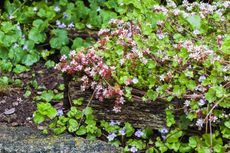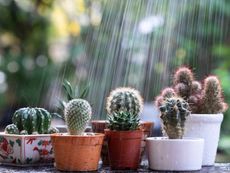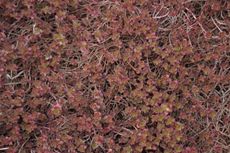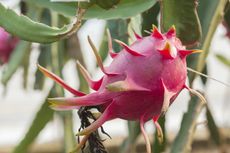Cacti & Succulents
So you want to grow cacti and succulent plants in the garden but don’t know where to start. That’s simple. Tips for growing, caring and designing with succulents and various types of cactus begins here. Use our cacti and succulent growing guide to help answer any questions you may have. There are many types of cactus and succulent plants that can be grown in the home garden, and most are easy to grow. Keep reading to learn more about designing with succulents and start creating cactus gardens that your neighbors will envy!
Explore Cacti & Succulents
-

English Stonecrop Care: Tips For Growing English Stonecrop
English stonecrop plants are common nursery plants and make excellent fillers in containers and beds. There are very few tricks on how to grow English stonecrop sedum and the information in this article will help.
By Bonnie L. Grant
-

What Are Echinocereus Plants – Information On Echinocereus Cactus Care
Cacti, such as those within the genus Echinocereus, are ideal candidates for culture in containers, as well as great outdoor options for adding unique visual interest to flower beds, borders, and drought-tolerant landscapes. Learn more about them in this article.
By Tonya Barnett
-

Caring For Ramillette Echeverias – Information About Ramillette Succulents
The Ramillette echeveria plant is also called Mexican hens and chicks, but don’t be misled. These plants are only hardy in USDA zones 9-11 for year-round outdoor planting and growing. Click here to learn more about caring for a Ramillette echeveria plant.
By Becca Badgett
-

Dazzling Succulents - Succulents With Striking Flowers
When you think of succulents you may just envision their unique leaves and stems. But succulents also produce bright and bold flowers in the right conditions. Read on to learn more.
By Bonnie L. Grant
-

What Is A Succulent Starter Kit - Best Succulent Starter Kits
While garden kits are not the most inexpensive option for growing succulents, they do include everything you’ll need. Grow succulents from seed by using a succulent seed starter kit to learn the process and to check your results.
By Becca Badgett
-

5 Best Succulents For A Bathroom
Some succulents can be great options for bathroom decoration. Read on for our top five bathroom succulent ideas.
By Becca Badgett
-

10 No Fuss Cacti - What’s The Best Low Maintenance Cactus
If you’re thinking of adding plants to your collection, consider no fuss cacti. Click here for an easy cacti list, even for beginners.
By Becca Badgett
-

Pink Succulents Varieties To Try: How To Grow Perfect Pink Succulent Plants
Pink succulents may display the color on leaf edges or with streaks or blotches mingled throughout the foliage. Here are our favorites.
By Becca Badgett
-

How To Protect Succulents And Cacti From Rain
Rain has the potential to cause damage to our cacti and succulents. However, when planted in proper soil, rainfall may perform as just a deep watering. Read on for more.
By Becca Badgett
-

Variegated Succulents To Add To Your Plant Collection
Read about some of the pretty variegated species that add beauty and interest to your succulent collection.
By Becca Badgett
-

Crassula Pagoda Plants: How To Grow Red Pagoda Crassula Plant
Red Pagoda Crassula is an easy-to-grow plant that will add punch to any succulent display or as a stand-alone specimen. Click here for tips on how to grow Red Pagoda and harness the impact of its structure and colorful foliage.
By Bonnie L. Grant
-

Dragon’s Blood Stonecrop: How To Grow Dragon’s Blood Sedum Plants
Dragon's Blood stonecrop is an exciting and attractive ground cover, spreading quickly in the sunny landscape and growing happily in many areas of the U.S. Its leaves fill in during the summer to become a deep burgundy by autumn. Learn more about this plant here.
By Becca Badgett
-

How To Get Dragon Fruit: Reasons For No Fruit On Pitaya Cactus Plants
Dragon fruit is a thoroughly tropical looking fruit you may have seen in the market. This bright pink, scaly fruit comes from a long, winding cactus of the same name. But what do you do if your pitaya won?t fruit? Learn how to make dragon fruit bear fruit in this article.
By Liz Baessler
-

Pitahaya Information: Learn How To Grow Dragon Fruit
If you want to grow dragon fruit at home, you'll be rewarded not only with fruit, but also with an impressive, branching cactus vine and brilliant, night-blooming flowers. This article provides info on how to grow dragon fruit.
By Liz Baessler
-

My Pitaya Won’t Bloom: Why Flowers Won’t Form On Pitaya Plants
Dragon fruit cactus, also known as pitaya, is a vining cactus with long, flattened leaves and brilliantly colored fruits that develop after the plant flowers. If there are no flowers on your plant, it may because you?re treating this tropical like a desert cactus. Learn more here.
By Mary H. Dyer
-

How To Divide A Succulent: Tips For Splitting Succulent Plants
If you want succulents without shopping or shipping fees, consider splitting succulent plants. When your plants have outgrown their pots or put out lots of babies, it’s time to divide your succulents. Click here to learn more about dividing a succulent plant.
By Becca Badgett
-

Christmas Cactus Cold Tolerance - How Cold Can Christmas Cactus Get
When you think of cactus, you probably envision a desert with heat wavering vistas and blazing sun. You aren't too far off the mark but the holiday cacti actually flower better in slightly cooler temperatures. Read here for Christmas cactus cold tolerance.
By Bonnie L. Grant

